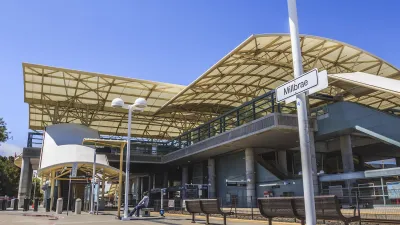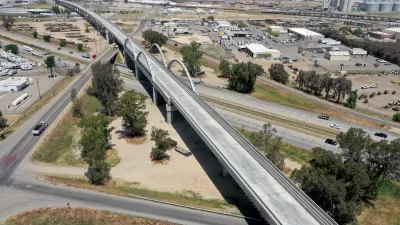Guidelines attached to the federal funds intended to help pay for the first phase of California's bullet train will require the fastest rate of transportation construction known in U.S. history, reports Ralph Vartabedian.
"The bullet train track through the Central Valley would cost $6 billion
and have to be completed by September 2017, or else potentially lose
some of its federal funding. It would mean spending as much as $3.5
million every calendar day, holidays and weekends included - the fastest
rate of transportation construction known in U.S. history, according to
industry and academic experts," writes Vartabedian.
To put that rate of spending into context, Vartabedian reports that other oft-cited examples of agreesive construction - the new Bay Bridge in Oakland and the Alameda Corridor freight rail line in Los Angeles - only managed to burn through $1.8 million per day.
"If the rail authority runs into technical problems, legal disputes,
permit delays or political roadblocks, it could end up building less
track and potentially leave an uncompleted project, according to
warnings contained in its own business plan. If the project blows past
the federal deadline, for example, the flow of money could be stopped.
And the scramble to meet that deadline could lead to construction
problems and drive up costs."
FULL STORY: High-speed spending: Bullet train may need $3.5 million a day

Trump Administration Could Effectively End Housing Voucher Program
Federal officials are eyeing major cuts to the Section 8 program that helps millions of low-income households pay rent.

Planetizen Federal Action Tracker
A weekly monitor of how Trump’s orders and actions are impacting planners and planning in America.

Ken Jennings Launches Transit Web Series
The Jeopardy champ wants you to ride public transit.

Tackling Soil Contamination With Nature-Based Solutions
Los Angeles County residents and experts are turning to nature-based methods like bioremediation to address long-standing and fire-exacerbated soil contamination without resorting to costly and disruptive removal.

Rebuilding Smarter: How LA County Is Guiding Fire-Ravaged Communities Toward Resilience
Los Angeles County is leading a coordinated effort to help fire-impacted communities rebuild with resilience by providing recovery resources, promoting fire-wise design, and aligning reconstruction with broader sustainability and climate goals.

When Borders Blur: Regional Collaboration in Action
As regional challenges outgrow city boundaries, “When Borders Blur” explores how cross-jurisdictional collaboration can drive smarter, more resilient urban planning, sharing real-world lessons from thriving partnerships across North America.
Urban Design for Planners 1: Software Tools
This six-course series explores essential urban design concepts using open source software and equips planners with the tools they need to participate fully in the urban design process.
Planning for Universal Design
Learn the tools for implementing Universal Design in planning regulations.
Ada County Highway District
Clanton & Associates, Inc.
Jessamine County Fiscal Court
Institute for Housing and Urban Development Studies (IHS)
City of Grandview
Harvard GSD Executive Education
Toledo-Lucas County Plan Commissions
Salt Lake City
NYU Wagner Graduate School of Public Service





























